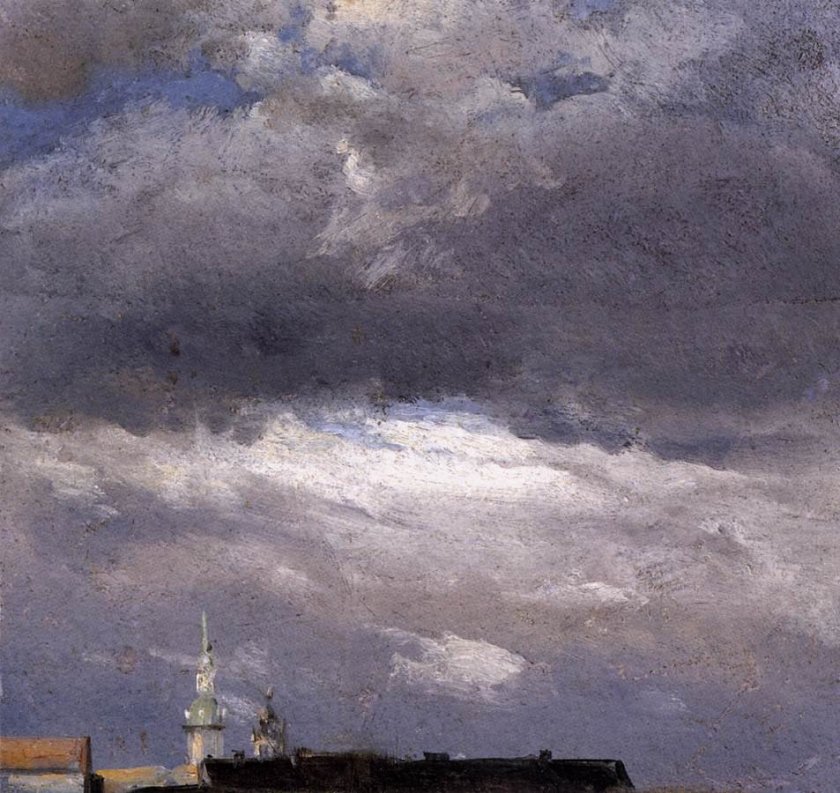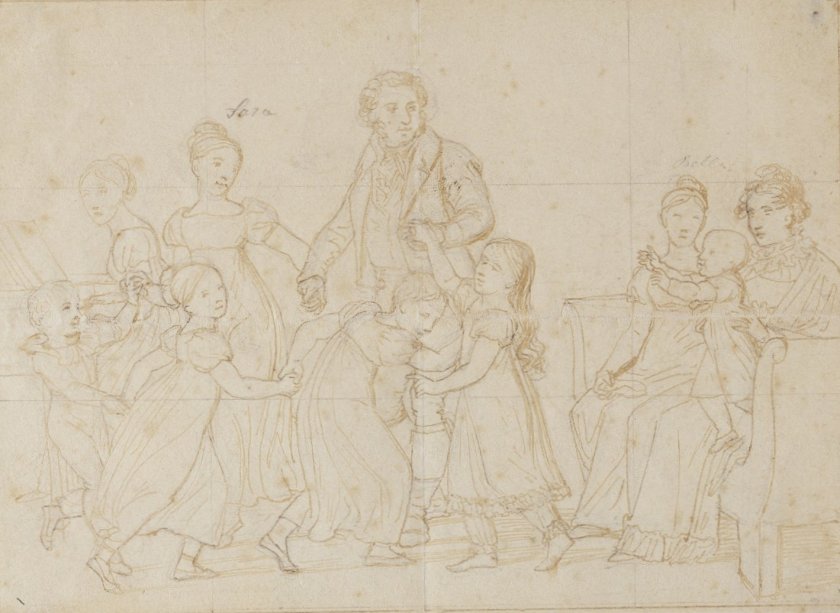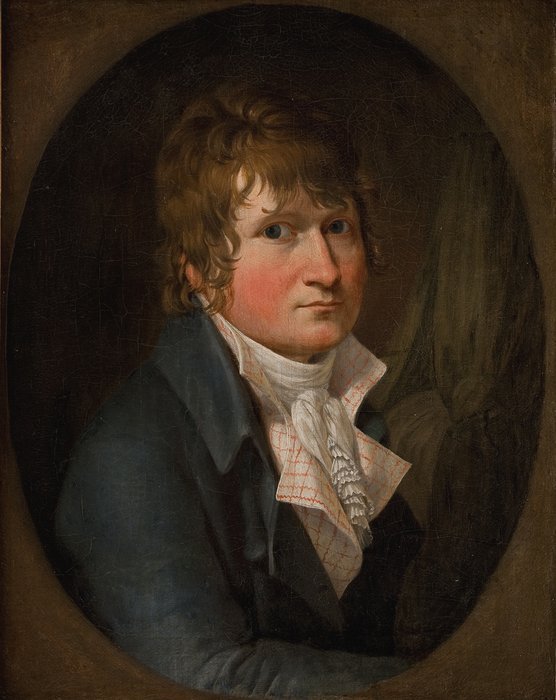If there is one other thing I have learnt since taking an interest in art is that by reading up on the paintings and the artists one learns a lot about history, whether it be European or American. One picks up on things which should have been learnt at school but sadly passed one by. Today’s look at the work and life of Christoffer Eckersberg is a good example of this in the way I have learnt a little about Danish history.
In 1807 the British shelled the Danish capital, Copenhagen. This was the second ferocious onslaught on the Danish city as six years earlier a similar attack had been made. It was all to do with the Napoleonic War and the Franco-Russian alliance secret agreement to ensure that Denmark and Sweden would assist them in a naval blockade of British trade. British diplomats went to Copenhagen to ask the Danish government to put their naval ships under British command until the Napoleonic War had ended but the Danes would not agree and so on September 2nd 1807, the British army landed in Denmark and attacked the Danish capital. The Danes finally surrendered and their naval ships were taken over by British sailors and sailed to England that October.

The Royal Library, Copenhagen
My first painting I am looking at today by Christoffer Eckersberg, The Fire of the Church of Our Lady, records the terrible onslaught on Copenhagen and is a prime example of history through art. The work shows the burning of the church steeple of the cathedral of Copenhagen, during the night of September 4th 1807. The steeple eventually fell to the ground. In the painting we see the pandemonium in the neighbouring street due to the fierce assault and the resulting blitz.

(50 x 60cms)
Museum of National History, Frederiksborg Castle
Another of Eckersberg’s painting depicting the bombardment of Copenhagen can be seen in his 1807 work The Bombardment of Copenhagen. View from Østervold. Shortly after the British naval bombardment of the Danish capital, Eckersberg, who was living in Copenhagen, made many drawings, for prints, of the conflagration of the most famous landmarks of the city and by doing so captured for posterity the terrible events. He managed to capture the feeling of panic which gripped the citizens of Copenhagen when the first shells fell on their beloved city. Works like this were in general demand and brought about a patriotic stirring that swept through the Danish population in the wake of this British bombardment.

(21 x 22cms)
Nationalgalerie Berlin
When Eckersberg returned to Denmark in 1816 after his stays in Paris and Rome he lost contact with most of the international artists of the time, with one exception, the Norwegian painter J C Dahl. Johan Christian Dahl lived in Norway but spent much time in Dresden and would pass through Copenhagen on his journeys between there and his homeland. It is known that J C Dahl was fascinated by clouds and their formation and had produced many works featuring this natural phenomenon, one of which was his 1825 painting, Cloud Study, Thunder Clouds over the Palace Tower at Dresden. For Dahl, the sky was an integral part of a landscape painting, and he would spend many hours observing cloud formations and watch as they crossed over land.
Eckersberg and Dahl developed a lasting friendship and it could have been Dahl’s fascination with clouds and his interest in meteorology that infected Eckersberg, so much so that Eckersberg began a twenty-five year hobby of keeping a daily meteorological diary and would regularly sketch cloud formations. J C Dahl would also have informed Eckersberg about how both artists and art theorists in Dresden were showing great interest in cloud formations. Eckersberg was also fascinated by the work of Luke Howard the English manufacturing chemist and amateur meteorologist who in 1802 classified the various tropospheric cloud types and believed that the changing cloud forms in the sky could unlock the key to weather forecasting.

In 1826 Eckersberg decided to master the art of painting clouds and he took himself off to Kalkbraenderibugten, a bay just north of Copenhagen so that he could paint a range of studies of clouds over water and the painting above, Study of Clouds over the Sea, is one he completed that year

(32 x 59cms)
Statens Museum for Kunst, Copenhagen
Looking at Eckerberg paintings so far I have concentrated on his mythological and biblical works along with some of his portraiture and nude studies but another genre of works favoured by Eckersberg was his marine works which also featured cloud depictions. A prime example of this is a work he completed in 1827 entitled A Russian Fleet at Anchor near Elsinore.

The next marine painting by Eckersberg I am featuring could well have come about from a visit he made to the atelier of Casper David Friedrich in Dresden in 1816, on his way home from Rome. It is quite possible that during that meeting he saw Friedrich’s newly completed work View of a Harbour.

(63 x 51cms)
Statens Museum for Kunst, Copenhagen
This marine painting by Eckersberg is one of my favourites and also one of his best known marine works. It is his magnificent 1828 painting entitled The Russian Ship of the Line “Asow” and a Frigate at Anchor in the Elsinore Roads. It is a triumph of detail, not just of the vessel itself and the way he has truthfully represented all the details of the rigging but how he has painstakingly depicted the cloud formation. So can we look at this as a mastering of plein air painting? Actually, no ! This is an idealised marine painting made up from a number of Eckersberg’s sketches done at different times and different locations. He may have been able to see some Russian ships at the Elsinore Roads in 1826, but at a great distance away, and it was not until sometime later that he observed a number of Russian ships at close quarters when they were at anchor in the Copenhagen Roads and it was during that fleet’s visit that he was able to go aboard the admirals’ ship, Azob, (although he later called it Asow !). He started the painting in 1828 and for accuracy got hold of some constructional drawings of the vessels from the naval dockyard. He even went as far as consulting his meteorological diary to check the weather conditions on the day the Asow was at anchor off Elsinore, and so the completed 1828 painting is not what Eckersberg saw on that day at Elsinore in 1826 but what he would have seen if he had been able to set off from land in a boat to witness, close up, the mighty Asow.
Eckersberg loved marine painting and in his later years concentrated on this genre at the expense of his once favoured landscape works.

A View towards the Swedish Coast from the Ramparts of Kromborg Castle by Eckersberg is another example of his marine/cloud painting. From his diary we know that this plein air work was started in September 1826 but was not completed until January1829 . The artist had positioned himself on the ramparts of the castle looking out across the Øresund towards the coast of Sweden, which was just four kilometres away. The castle which is on the extreme north-eastern tip of the island of Zealand is in the town of Helsingor and was immortalised as Elsinore in Shakespeare’s play Hamlet. It is a painting which doesn’t just focus on ships and clouds but looks at life going on inside the castle. We see two maids tending to newly-washed clothes. We can also see military personnel looking out at the warship in the Øresund strait. They are engaged in guarding the castle and stand by the gun emplacements. A Danish flag flutters in the wind as a reminder of the importance of the fortification to the country

(48 x 64cms)
Statens Museum for Kunst, Copenhagen
My final look at Eckersberg’s marine paintings is one he completed in 1839 with the title The Corvette Galathea in a Storm in the North Sea. Eckersburg had been a passenger on the vessel in the May of that year when it was crossing the North Sea on its way to Dover and encountered a fierce storm, which lasted two whole days. On his return home he wrote up about this dramatic voyage in his diary which he later translated into this painting. In his diary he wrote:
“…hideously rough waters, in which the ship veered horribly, now up and down, now to one side or the other, making it difficult to hold on tight………when the sun was shining the sea had the most extraordinary beautiful colour, pure blue and green, with glittering white foam….”
Eckersberg’s depiction of the Galathea is as if he had been witnessing the event from another vessel. The sketches he made in the diary of the event were full of blues and greens of the sea, interrupted by the white of the foam which topped the waves.
The painting was completed in a month, on his return home from Hamburg.

(35 x 26cms)
Ribe Art Museum
Another of my favourite Eckersberg painting has a nautical theme and yet there is no sign of a ship. It is a quirky work entitled A Sailor Taking Leave of His Girl which he completed in 1840. He recorded the completion of this work in a diary on June 25th 1840, in which he wrote that he had “completed a small painting depicting a sailor taking leave of his girl”. It was Eckersberg’s interest in depicting everyday scenes and quite ordinary events in his art which resulted in a work like this. This type of work featuring scenes from the streets of Copenhagen was favoured by him back in the days when he was attending as a student at the Royal Danish Academy of Art. In this small work Eckersberg has offered a small part of a relationship story between a sailor and a lady and has left us to fill in the background to the happening we see before us. He referred to this type of depiction as a “fleeting moment”. Look at the shadows on the wall. In the painting we see the man and woman drifting apart and yet the shadow shows them merged. Maybe these two images are asking us to decide what comes next. Is it a final parting or will there be a reunion? Look how the sailor points to the shadow. Is this a reassuring gesture to the woman that one day they will be “as one”? Maybe that is just too romantic a reasoning. Maybe it is simply a sailor on leave from his ship wanting to seduce the young woman and take her off to a more secluded place. I will leave you to decide !

(45 x 33cms)
Statens Museum for Kunst, Copenhagen
My final offering is also a “fleeting moment” depiction. Eckersberg completed Langebro, Copenhagen, in the Moonlight with Running Figures in 1836. This is what is termed as one of Eckersberg’s “unresolved narratives”. The idea for this work came to Eckersberg in October 1836 when he was taking a stroll along the waterfront. He decided to paint a depiction of the bridge, not in the daytime but he decided to make it part of a nocturnal moonlight scene. To the depiction of the bridge he has added a number of people running along it, towards us. As was the case in the previous work, Eckersberg has depicted a scene and let us, the observers, work out what is going on. Are the people running away from something, such as a fire or are they running towards something? There are certainly signs of desperation in the way the people have been portrayed. Look at the woman by the bridge railing. What is she pointing at? The painting poses many questions. One line of thought is that in the same year Eckersberg completed the work the Danish novelist Carl Bernhard published his new work Dagvognen (The Stagecoach), the climax of which is set on the Langebro and told of a young man rescuing a young woman who is trying to drown herself.
Christoffer Eckersberg was married three times. In the Part 1 of this blog I talked about his first and somewhat disastrous marriage to Christine Rebecka Hyssing the father of his first child. This ended in divorce in 1816 after just three years. The following year he married Julie Juel, the daughter of his great mentor, the Danish portrait painter, Jens Juel. Julie died in 1827. A year later, in 1828, Eckersberg, aged 45 married Julie’s sister Sanne. They were married for twelve years until her death in 1840. Eckersberg fathered eleven children.
Christoffer Wilhelm Eckersberg died in 1853 of cholera. He was seventy years of age.


























![View of the Capitoline Hill with the Steps that go to the Church of Santa Maria] d’Aracoeli) by Paranesi (c.1757)](https://mydailyartdisplay.files.wordpress.com/2016/05/view-of-the-capitoline-hill-with-the-steps-that-go-to-the-church-of-santa-maria-d_aracoeli-by-paranesi-c.jpg?w=840&h=632)








 Another landscape Eckersberg completed in 1809 featuring the island was entitled The Cliffs of the Island of Møn. View of the Summer Spire. The chalk cliffs on the eastern coast of the island, known as Møns Klint, and the surrounding woodlands and pasture lands has attracted an estimated quarter of a million visitors every year and is the favourite location for artists as it was in the nineteenth century. Christopher von Bülow had his Nordfeld estate near the cliffs so this was probably the reason for Eckersberg depiction. It gave the artist the chance to depict the elements of nature which made the area so loved. The high white limestone peak we see in the background is the Sommerspirit or Summer spire which rises to a height of 102 metres. Unfortunately this natural wonder can no longer be seen as in January 1988 it crashed into the sea due to coastal erosion below its base. Maybe there is a touch of humour in the painting as we Eckersberg depicting a petrified woman shrink back from the edge of the cliff in fear, despite the soothing overtones from her male companion.
Another landscape Eckersberg completed in 1809 featuring the island was entitled The Cliffs of the Island of Møn. View of the Summer Spire. The chalk cliffs on the eastern coast of the island, known as Møns Klint, and the surrounding woodlands and pasture lands has attracted an estimated quarter of a million visitors every year and is the favourite location for artists as it was in the nineteenth century. Christopher von Bülow had his Nordfeld estate near the cliffs so this was probably the reason for Eckersberg depiction. It gave the artist the chance to depict the elements of nature which made the area so loved. The high white limestone peak we see in the background is the Sommerspirit or Summer spire which rises to a height of 102 metres. Unfortunately this natural wonder can no longer be seen as in January 1988 it crashed into the sea due to coastal erosion below its base. Maybe there is a touch of humour in the painting as we Eckersberg depicting a petrified woman shrink back from the edge of the cliff in fear, despite the soothing overtones from her male companion.



